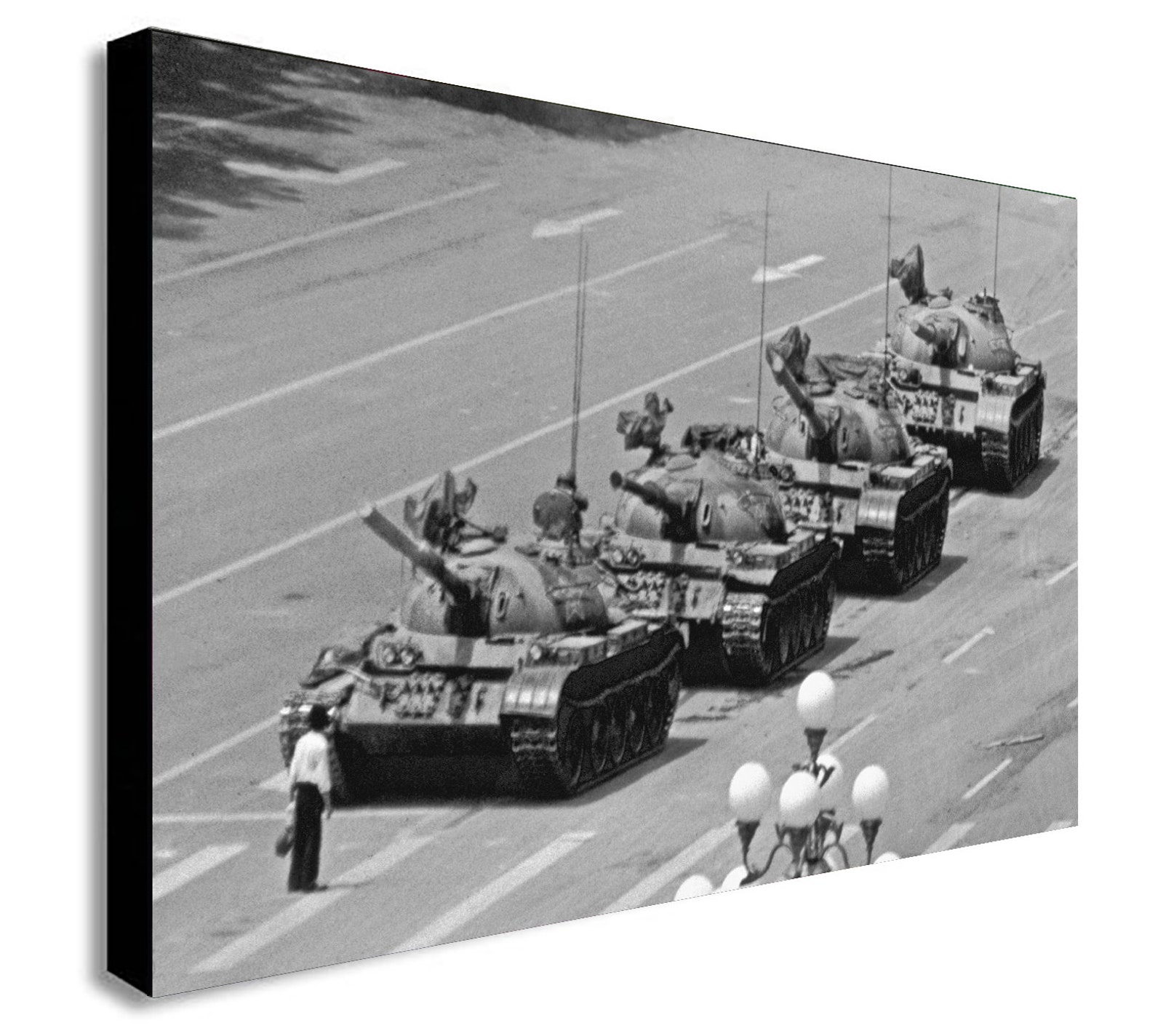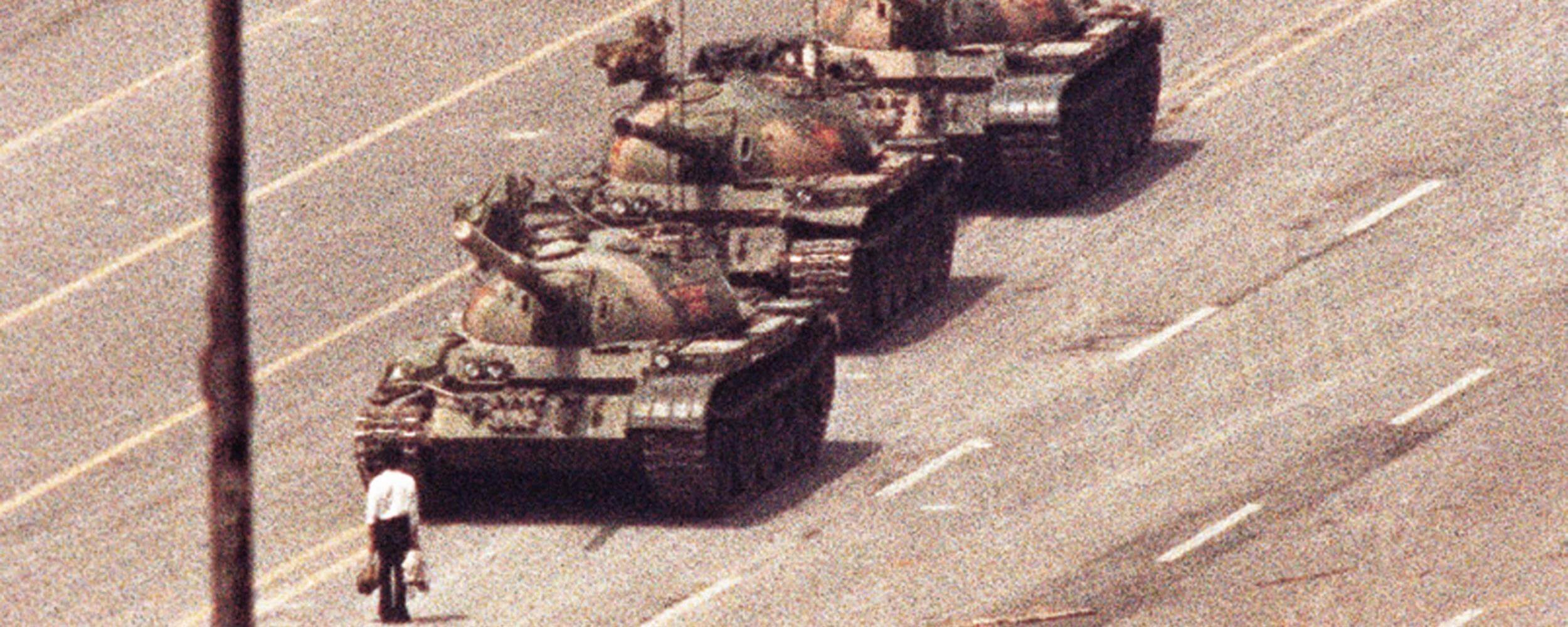
The tank commander briefly emerged from his hatch, and the tanks restarted their engines, ready to continue on. After ending the conversation, the man descended from the tank. He then climbed atop the turret and seemed to have a short conversation with a crew member at the gunner's hatch. Having successfully brought the column to a halt, the man climbed onto the hull of the buttoned-up lead tank and, after briefly stopping at the driver's hatch, appeared in video footage of the incident to call into various ports in the tank's turret. There was a short pause with the man and the tanks having reached a quiet, still impasse. After repeatedly attempting to go around, the lead tank stopped its engines, and the armored vehicles behind it followed suit. In response, the lead tank attempted to drive around the man, but the man repeatedly stepped into the path of the tank in a show of nonviolent action. As the tanks came to a stop, the man gestured at them with one of the bags.

Stuart Franklin, who was on assignment for Time magazine, told The New York Times: "At some point, shots were fired and the tanks carried on down the road toward us, leaving Tiananmen Square behind, until blocked by a lone protester." He wore a white shirt and black trousers, and he held two shopping bags. At least one witness has stated that Tank Man was not the only person to have blocked the tanks during the protest, but Tank Man is unique in that he is the only one who was photographed and recorded on video.Īt the northeast edge of Tiananmen Square, along Chang'an Avenue, shortly after noon on June 5, 1989, the day after the Chinese government's violent crackdown on the Tiananmen protests, "Tank Man" stood in the middle of the wide avenue, directly in the path of a column of approaching Type 59 tanks. There is no reliable information about the identity or fate of the man the story of what happened to the tank crew is also unknown. Inside China, the image and the accompanying events are subject to censorship. Internationally, it is considered one of the most iconic images of all time. The incident was filmed and shared to a worldwide audience. As the lead tank maneuvered to pass by the man, he repeatedly shifted his position in order to obstruct the tank's attempted path around him. Tank Man (also known as the Unknown Protester or Unknown Rebel) is the nickname of an unidentified Chinese man who stood in front of a column of Type 59 tanks leaving Tiananmen Square in Beijing on June 5, 1989, the day after the Chinese government's violent crackdown on the Tiananmen protests. To delve more into the New Scientist archives, go to newscientist.Iconic photo of him obstructing tanks during the aftermath of the 1989 Tiananmen Square protests and massacre.The very technology that made modern global news coverage possible is now, it seems, rendering it unbelievable. Smartphones allow us to alter images at the touch of a screen, and concerns are being raised about “deep fakes” – digital imaging technology that stitches images together to make video footage that looks real, but is anything but. The beginnings of the innovations that would drive the smartphone camera revolution two decades later were already visible.

This development could eventually cut the cost and size of the camera, because it does not need a disc drive.”
#TANK MAN TIANANMEN SQUARE VIDEO CODE#
Fuji was proposing a different approach, “a camera which records picture signals as digital code in solid state memory.

Storage was an issue: the go-to method for digital storage was a magnetic floppy disc. “Electronic cameras come into their own, however, when time is short, because it takes only about four minutes to send a colour picture and there is no time lost developing the photograph,” he wrote.

Our correspondent Barry Fox, reporting from the Consumer Electronics Show in Chicago, suspected that the Japanese were ahead of the game. “Japanese newspapers are using electronic still picture cameras, made by Canon and Sony, while the American news agency, Associated Press, prefers to use a new technique for transmitting film images by telephone.” This used a machine that scanned developed negatives with a beam of light, the snag being that the film first had to be developed. The technology was so new that no one was yet sure of how best to implement it. “Photographers are sending pictures out of China down phone lines using some of the latest electronic still picture techniques,” we explained.


 0 kommentar(er)
0 kommentar(er)
